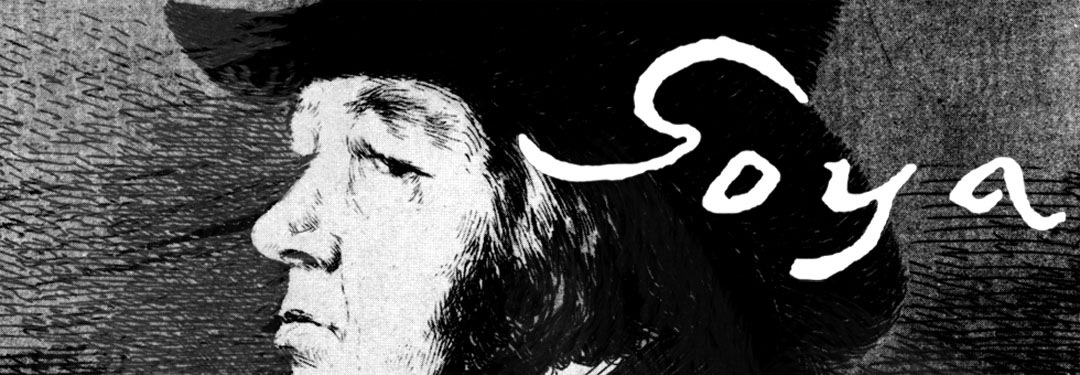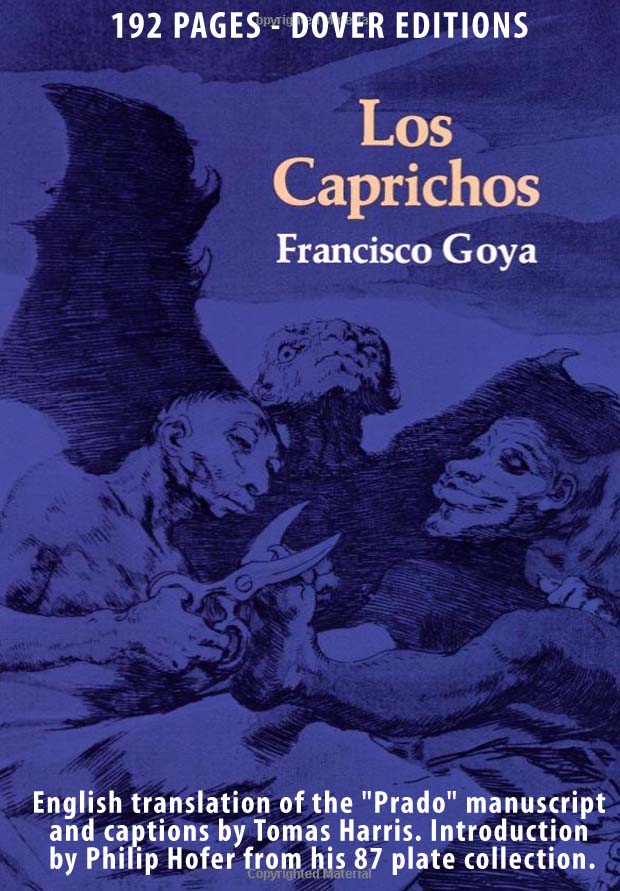Goya Site Statistics
Updated: June 12, 2007
May 2007: 31,577 unique visitors, 114,617 page views.
April 2007: 29,843 unique visitors, 107,283 page views.
March 2007: 28,114 unique visitors, 118,418 page views
January 2007: 115,317 Page Visits, 1,025,460 Hits
December 2006: 101,698 Page Visits, 765,472 Hits
November 2006: 127,274 Page Visits, 919,175 Hits
These numbers are from my AW Stats package built into the cpanel controller for the site.
A Timeline of the Life of Goya 1746-1779 | 1780 - 1799 | 1800 - 1828
1746-1779
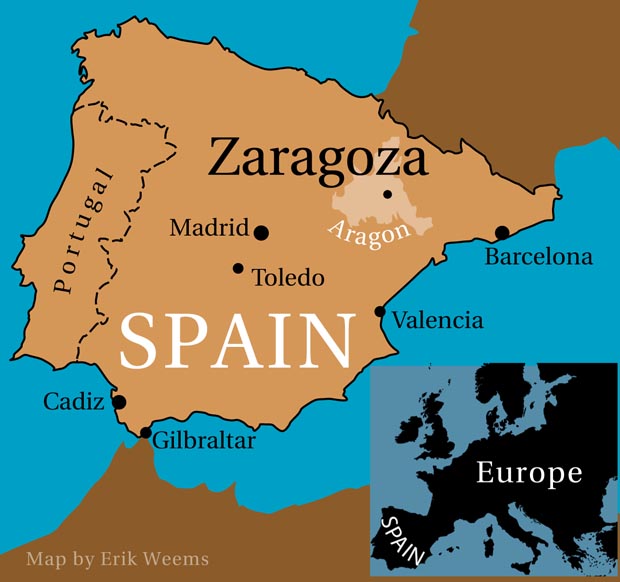
Born March 30, 1746
This is the same year than King Ferdinand VI ascends to the Spanish throne.
Goya was born in the village of Fuendetodos on March 30, 1746. This small, hillside village is slightly below the large city of Zaragoza (sometimes spelled in translation as "Saragossa"). Goya's parents left Fuendetodos and moved to Zaragoza shortly after his birth (1749). He is the fourth son in the family.
Goya's father - Jose Francisco de Paula Goya - worked as a master gilder.
Goya's mother, Gracia Lucientes, came from a Hidalgo* family. She is also mother Goya's siblings, Rita (b.1737), Jacinta (b.1743), Mariano (b.1750) and Carmilo (b.1752).
*Hildago: from a noble family.
Factual information on Goya's early years is sparse. Many biographers have speculated that his father's trade influenced the young boy, or that his mother, who may have come from a wealthy family, might have had more refined tastes and thus influenced her third born. But there are few documents or records to establish a clear origin to Goya's later abilities and directions.
Goya, as a much older man involved in the matters of court where he was Royal painter, would go to the trouble to establish that his family was descended from a Basque family of Cerain, an important ancestral link in the aristocratic concerns of Spain. But beyond these genealogical trails, there are few items on record of his early experience.
Goya attended a "pious school," one of many free schools that were the result of Joseph of Calasanz's** efforts to provide an education to the poor of Spain. (Goya would later paint an 1819 alter piece of Joseph for the church of San Antón Abad in Madrid, which he contributed at a small price to the priests there). It is in this early schooling that he made his life-long friendship with Martin Zapater, with whom he would exchange correspondence for much of his life.
**Sometimes identified as Joseph Calasanctius. He was a Spanish Catholic priest who founded the Pious Schools which provided free education for the poor.
1760
Goya was apprenticed to the Zaragoza painter José Lúzan y Martinez (1710 - 1795) at the age of 13 (some biolgraphies say he was 14). Goya later wrote of this in a short autobiography for the Prado Museum catalog of 1828:
'He was a pupil of Don Jose Luzan in Zaragoza, with whom he learned the principles of drawing and who made him copy the finest engravings that he possessed; he stayed with him for four years and his painting continued to be influenced by him until he went to Rome.'
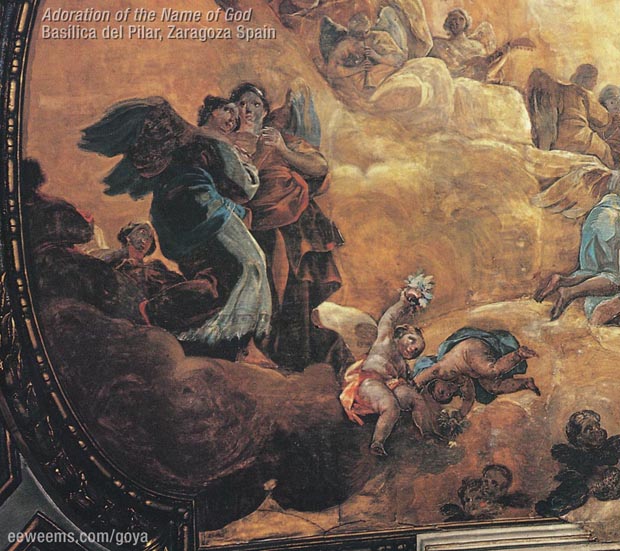
Adoration of the Name of God
Goya submitted entries for the Spanish Royal Academy in 1763, and 1766, each time he was denied entrance to the school. He was twenty-years old when the 1766 failure occurred, and it is then that he embarked for a journey to Italy. As the center of the world of art, Italy was frequented by artists from many countries. He lived there two years, won an award for painting skill at an open competition provided by the Academy of Parma (Hannibal Crossing the Alps. A recently discovered sketch of this can be seen on this Goya site news page), and he completed several small oils which still survive. In the more romanticized tales of Goya, he is supposed to have carved his name into the lantern at St. Peter's. He might have stayed longer in Italy, but was given notice by friends that the Basilica del Pilar in Madrid was to be painted with a fresco, and he was summarily invited to submit plans to the Real Academia de S Fernando. On June 1, 1772 he completed The Adoration of the Name of God (detail) (see full frame)
1774
First child is born, does not survive infancy.
1775
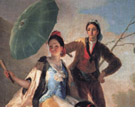 In July, Goya married Josefa Bayeu, the sister of Francisco and Ramon Bayeu, painters who had already established themselves in Spain. The couple lived in Zaragoza for a year, but was asked to come to Madrid by the court painter Mengs*, who, despite being born in Dresden, had become First Painter to the King. Selected to work in the Royal Tapestry Factory, Goya labored under the supervision of his brother-in-law Francisco (see, for example, The Parasol). Although Goya was allowed to keep the initial color sketches for the tapestries that he designed, the finished "cartoons" (as they were called) became property of the king. The many cartoons Goya completed were not discovered until the late 19th century, stored in rolls in the basement of the Royal Palace in Madrid, Spain. In December, the second child is born to Josefa and Francisco Goya. The child does not survive infancy.
In July, Goya married Josefa Bayeu, the sister of Francisco and Ramon Bayeu, painters who had already established themselves in Spain. The couple lived in Zaragoza for a year, but was asked to come to Madrid by the court painter Mengs*, who, despite being born in Dresden, had become First Painter to the King. Selected to work in the Royal Tapestry Factory, Goya labored under the supervision of his brother-in-law Francisco (see, for example, The Parasol). Although Goya was allowed to keep the initial color sketches for the tapestries that he designed, the finished "cartoons" (as they were called) became property of the king. The many cartoons Goya completed were not discovered until the late 19th century, stored in rolls in the basement of the Royal Palace in Madrid, Spain. In December, the second child is born to Josefa and Francisco Goya. The child does not survive infancy.
*Anton Raphael Mengs, Born March 22, 1728, died June 29, 1779.
1777
Birth of third child, who does not live beyond infancy.
1778
Mengs allows Goya to come to the Royal Palace, where he begins studying the paintings of Velasquez.
1779
Fourth child born, will not live beyond infancy.
1780 -1799
1780
 Work in the Tapestry factory was suspended while Spain's war with England took up the majority of the Royal family's time and money. Through his brother-in-law, Goya was accepted into the Royal Academy in Madrid. His application painting was the 1780 painting Crucifixion. At the end of the year, he accompanied Francisco to Zarogoza for a collaborated project. Unable to cooperate with each other, Goya and Francisco experienced a terrible rift in their working and personal relationship. A Fifth child is born but will not survive.
Work in the Tapestry factory was suspended while Spain's war with England took up the majority of the Royal family's time and money. Through his brother-in-law, Goya was accepted into the Royal Academy in Madrid. His application painting was the 1780 painting Crucifixion. At the end of the year, he accompanied Francisco to Zarogoza for a collaborated project. Unable to cooperate with each other, Goya and Francisco experienced a terrible rift in their working and personal relationship. A Fifth child is born but will not survive.
1781
Returning to Madrid after the dissolution of his partnership with Francisco for the Zaragoza project, Goya took up a royal commission for the alter piece at the church of San Francisco el Grande. Since Bayeu was one of the other six Academicians who were commissioned for art for the church, Goya spent two years finishing the work, making certain that his work should stand up well against his former supervisor at the Tapestry factory.
1782
Sixth child born to not survive.
1783
Goya paints the Count Floridablanca, which is his first important commission. It's success opens doors that begin Goya's professional advancement to eventually becoming First Painter to the King in 1786.
1784
Xavier, the only child that Goya and his wife Josefa had which survives infancy, is born on December 2. Goya's work as a portrait painter continues to improve and his clientele list to grow.
1785
Goya is named the Deputy Director of Painting at the Royal Academy. This is a lucrative position that allows Goya to begin receiving fashionable portrait commissions among the wealthier classes in Spain.
1786
Goya is appointed Painter to the King. This is the most prestigious position for an artist in Spain, and also comes with a steady income, securing Goya's finances. Goya had petitioned for this position in 1779, when Mengs had died, but it was not then accepted. Along with his new position, though, Goya is required to return to the Royal Tapestry Factory, where he begins again creating unique cartoons. These demonstrate his new-found confidence and intellectual thought in developing his themes. A representative image is The Snowstorm.
1788
With the death of Charles III, Charles IV ascends the throne. The new King and his wife change the Spanish elites' cultural affections for French and Italian art, introducing a fashionable acceptance of Spanish works.
1792
Goya suffers a terrible illness while visiting his patron Sebastian Martinez. Staying at Martinez' home, Goya paints a series of "Cabinet" pictures on tin. These are sent to the Academy in Madrid for inspection and to be sold to help Goya recover his financial losses during his illness.
1795
Now deaf from his illness, Goya is commissioned to paint full-length portraits of the Duke and Duchess of Alba. When The Duke suddenly dies a year later, Goya is one of the people asked to keep the Duchess company during her period of mourning. His time there is punctuated with many drawings, many apparently of the Duchess in intimate settings. Some of these more ironic or bitter images would later appear in altered form in the etchings of The Caprichos.
1797
Goya paints his second formal portrait of the Duchess of Alba. The image indicates some form of intimate relationship, as the picture shows the black-adorned widow pointing in the sand where is written "Solo Goya." (The image is never delivered - - if indeed it was a portrait commission to begin with - - and is still a part of Goya's personal collection when he dies. Goya's son Xavier inherits the painting, who was also named in the Duchess' will for an inheritance of a small income from her estates.) Goya begins working on the eighty images that will comprise The Caprichos. It is also in this period when Goya first begins composing images dealing with the witchcraft practices in Spain, usually considered in analytical studies as veiled references to the Inquisition then operating with deadly powers of authority in Spain.
1798
Goya paints a large scale fresco at the newly constructed church San Antonio de la Florida. Goya had been working almost exclusively small-scale work to conserve his strength, which was greatly affected by his illness, but this physically intensive fresco demonstrates his recovery was almost complete. He is however still deaf, and complains in conversation with the King that but for sign language, he would almost be completely cut-off from the hearing world.
1799
Within 15 days of the release of The Caprichos, they are withdrawn from public sale, and only a formal order from the King of Spain keeps Goya from being called before the Inquisition.
1800
Goya is busy painting portraits of the Royal family of Charles IV. It is also at this time that he completes the Majas desnuda and Vestida.
1802
The Duchess of Alba dies on June 23rd at the age of 40. Goya will design a number or unrealized plans for a funeral monument to the Duchess.
1803
Goya's lifelong friend and correspondent Martin Zapater dies.
1808
Charles IV abdicates the throne, turning it over to his son Ferdinand VII. Civil strife leads to the executions in Spain by occupying French troops. These events would become subjects for several of Goya's later works such as the Second and Third of May paintings). The throne of Spain is taken by Joseph Bonaparte, Napoleon's brother, backed by a large French military force.
1809
Goya, along with many other Spanish artists, are ordered to choose fifty paintings for Napoleon's museum in Paris.
1810
Goya begins work on the Disasters of War etchings.
1812
Josefa Bayeu Goya dies, leaving Goya and their son Xavier her own small collection of paintings (the written catalog of her belongings will later be the basis for many insights into Goya's personal life, and for establishing a resume of Goya's works). French troops in Spain are defeated by Britain's General Wellington leading a coalition of anti-Bonaparte forces. Soon thereafter Wellington sits for Goya, who by then has painted formal portraits of the leadership from all sides - both Spain, France and Britain.
1814
Ferdinand VII reinstated to the Spanish throne, and Goya, along with many of the other Spanish republican liberals, are in danger of Jail. The Inquisition renews its practises.
1815
Goya's painting of Majas desnuda and Vestida cause him to be brought before the Inquisition.
1819
Goya buys the home that will become the Quinta del Sordo, the "House of the Deaf Man." He begins painting the Pinturas Negras on the walls - - the so-called "Black Paintings." During the winter he becomes gravely ill.
1823
Goya, still under threat from the Inquisition and the powerful political factions under Ferdinand, signs his home over to his grandson Mariano. Goya petitions Ferdinand to leave Spain for France, describing health concerns requiring the medicinal bathes in Bordeaux. After entering France, he settles in Paris.
1824
Leocadia Zorrilla comes from Spain with her children, stays with Goya as his housekeeper. They settle together in Bordeaux.
1825
Goya works on a series of bullfight lithographs, and paints forty miniatures on ivory.
1826
 Goya returns to Spain temporarily to request indefinite leave, Ferdinand grants this and also a retirement pension. The King also orders that an official portrait of Goya be done by Vincente Lopez. (Shown left: click on the image for a large view.)
Goya returns to Spain temporarily to request indefinite leave, Ferdinand grants this and also a retirement pension. The King also orders that an official portrait of Goya be done by Vincente Lopez. (Shown left: click on the image for a large view.)
1827
 Goya paints Milkmaid of Bordeaux, several other portraits, and begins experimenting with lithography. He complains in his letters of failing eyesight and lack of art supplies. (Note - there is some dispute among art critics about whether Goya painted Milkmaid or if possibly Rosario, Leocadia's daughter, painted the image under Goya's tutorship. The painting has obvious characteristics of Goya's style - - but also consider that Rosario had a career as a painter after Goya's death. I have not seen any examples of her work and cannot form an opinion through comparison. - Erik)
Goya paints Milkmaid of Bordeaux, several other portraits, and begins experimenting with lithography. He complains in his letters of failing eyesight and lack of art supplies. (Note - there is some dispute among art critics about whether Goya painted Milkmaid or if possibly Rosario, Leocadia's daughter, painted the image under Goya's tutorship. The painting has obvious characteristics of Goya's style - - but also consider that Rosario had a career as a painter after Goya's death. I have not seen any examples of her work and cannot form an opinion through comparison. - Erik)
1828
Goya's health worsens, and on April 2nd his right side becomes paralyzed following a stroke. He lingers in a comatose state for two weeks, unresponsive and slowly edging toward death. He finally died at 2:00 a.m. in the morning on April 16th. Goya's funeral was on April 17, a special mass on his behalf spoken at the nearby Notre-Dame Cathedral. His corpse was then interred at the cemetery of the Chartreuse of Bordeaux, the grave-site next to Goya's son Javier's father-in-law, Martin Miguel de Goicoechea.
1901
Goya's remains are unearthed at the request of the Spanish government, and moved to a grave beneath the floor of the church of San Antonio de la Florida in Madrid, Spain. When his body was disinterred from France, the skull was found to be missing, and has not been located since.
This page revised August, 2011- Update June 2019
AMAZON
Goya The Terrible Sublime - Graphic Novel - (Spanish Edition) - Amazon
"From this headlong seizure of life we should not expect a calm and refined art, nor a reflective one. Yet Goya was more than a Nietzschean egoist riding roughshod over the world to assert his supermanhood. He was receptive to all shades of feeling, and it was his extreme sensitivity as well as his muscular temerity that actuated his assaults on the outrageous society of Spain." From Thomas Craven's essay on Goya from MEN OF ART (1931).
"...Loneliness has its limits, for Goya was not a prophet but a painter. If he had not been a painter his attitude to life would have found expression only in preaching or suicide." From Andre Malroux's essay in SATURN: AN ESSAY ON GOYA (1957).
"Goya is always a great artist, often a frightening one...light and shade play upon atrocious horrors." From Charles Baudelaire's essay on Goya from CURIOSITES ESTRANGERS (1842).
"[An] extraordinary mingling of hatred and compassion, despair and sardonic humour, realism and fantasy." From the foreword by Aldous Huxley to THE COMPLETE ETCHINGS OF GOYA (1962).
"His analysis in paint, chalk and ink of mass disaster and human frailty pointed to someone obsessed with the chaos of existence..." From the book on Goya by Sarah Symmons (1998).
"I cannot forgive you for admiring Goya...I find nothing in the least pleasing about his paintings or his etchings..." From a letter to (spanish) Duchess Colonna from the French writer Prosper Merimee (1869).
GOYA : Los Caprichos - Dover Edition - Amazon
